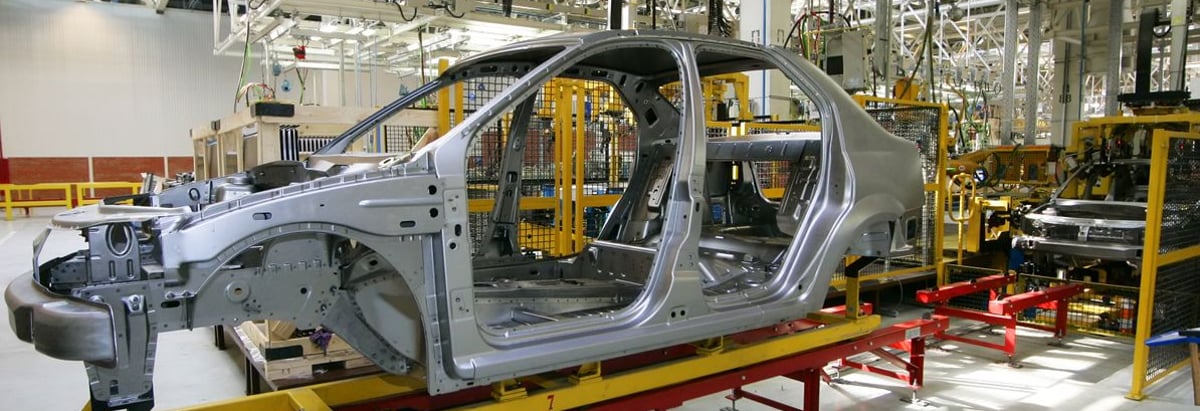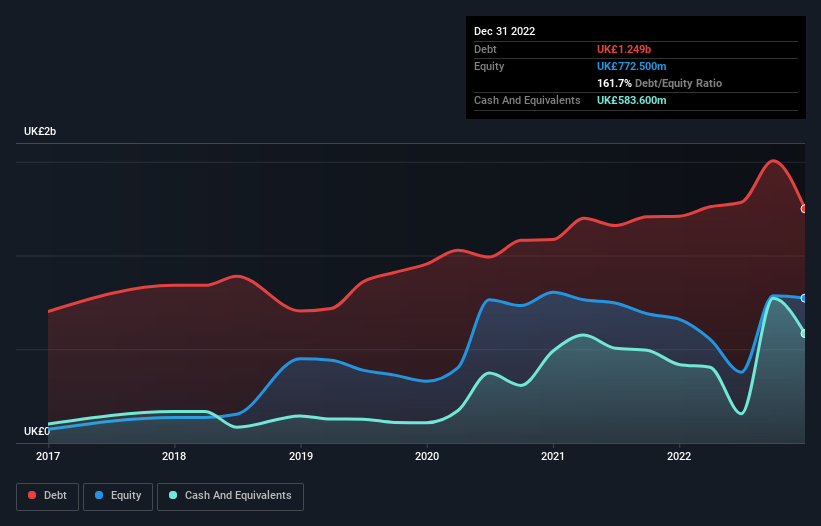- United Kingdom
- /
- Auto
- /
- LSE:AML
Is Aston Martin Lagonda Global Holdings (LON:AML) Using Debt In A Risky Way?

Warren Buffett famously said, 'Volatility is far from synonymous with risk.' It's only natural to consider a company's balance sheet when you examine how risky it is, since debt is often involved when a business collapses. We can see that Aston Martin Lagonda Global Holdings plc (LON:AML) does use debt in its business. But should shareholders be worried about its use of debt?
When Is Debt A Problem?
Generally speaking, debt only becomes a real problem when a company can't easily pay it off, either by raising capital or with its own cash flow. Ultimately, if the company can't fulfill its legal obligations to repay debt, shareholders could walk away with nothing. However, a more frequent (but still costly) occurrence is where a company must issue shares at bargain-basement prices, permanently diluting shareholders, just to shore up its balance sheet. By replacing dilution, though, debt can be an extremely good tool for businesses that need capital to invest in growth at high rates of return. The first thing to do when considering how much debt a business uses is to look at its cash and debt together.
See our latest analysis for Aston Martin Lagonda Global Holdings
What Is Aston Martin Lagonda Global Holdings's Net Debt?
As you can see below, Aston Martin Lagonda Global Holdings had UK£1.25b of debt, at December 2022, which is about the same as the year before. You can click the chart for greater detail. However, it also had UK£583.6m in cash, and so its net debt is UK£665.7m.

How Healthy Is Aston Martin Lagonda Global Holdings' Balance Sheet?
Zooming in on the latest balance sheet data, we can see that Aston Martin Lagonda Global Holdings had liabilities of UK£1.04b due within 12 months and liabilities of UK£1.29b due beyond that. On the other hand, it had cash of UK£583.6m and UK£200.9m worth of receivables due within a year. So its liabilities outweigh the sum of its cash and (near-term) receivables by UK£1.55b.
This deficit is considerable relative to its market capitalization of UK£1.62b, so it does suggest shareholders should keep an eye on Aston Martin Lagonda Global Holdings' use of debt. This suggests shareholders would be heavily diluted if the company needed to shore up its balance sheet in a hurry. The balance sheet is clearly the area to focus on when you are analysing debt. But ultimately the future profitability of the business will decide if Aston Martin Lagonda Global Holdings can strengthen its balance sheet over time. So if you want to see what the professionals think, you might find this free report on analyst profit forecasts to be interesting.
In the last year Aston Martin Lagonda Global Holdings wasn't profitable at an EBIT level, but managed to grow its revenue by 26%, to UK£1.4b. Shareholders probably have their fingers crossed that it can grow its way to profits.
Caveat Emptor
While we can certainly appreciate Aston Martin Lagonda Global Holdings's revenue growth, its earnings before interest and tax (EBIT) loss is not ideal. To be specific the EBIT loss came in at UK£119m. Considering that alongside the liabilities mentioned above does not give us much confidence that company should be using so much debt. So we think its balance sheet is a little strained, though not beyond repair. Another cause for caution is that is bled UK£160m in negative free cash flow over the last twelve months. So suffice it to say we consider the stock very risky. When analysing debt levels, the balance sheet is the obvious place to start. But ultimately, every company can contain risks that exist outside of the balance sheet. To that end, you should learn about the 2 warning signs we've spotted with Aston Martin Lagonda Global Holdings (including 1 which is a bit unpleasant) .
At the end of the day, it's often better to focus on companies that are free from net debt. You can access our special list of such companies (all with a track record of profit growth). It's free.
If you're looking to trade Aston Martin Lagonda Global Holdings, open an account with the lowest-cost platform trusted by professionals, Interactive Brokers.
With clients in over 200 countries and territories, and access to 160 markets, IBKR lets you trade stocks, options, futures, forex, bonds and funds from a single integrated account.
Enjoy no hidden fees, no account minimums, and FX conversion rates as low as 0.03%, far better than what most brokers offer.
Sponsored ContentNew: Manage All Your Stock Portfolios in One Place
We've created the ultimate portfolio companion for stock investors, and it's free.
• Connect an unlimited number of Portfolios and see your total in one currency
• Be alerted to new Warning Signs or Risks via email or mobile
• Track the Fair Value of your stocks
Have feedback on this article? Concerned about the content? Get in touch with us directly. Alternatively, email editorial-team (at) simplywallst.com.
This article by Simply Wall St is general in nature. We provide commentary based on historical data and analyst forecasts only using an unbiased methodology and our articles are not intended to be financial advice. It does not constitute a recommendation to buy or sell any stock, and does not take account of your objectives, or your financial situation. We aim to bring you long-term focused analysis driven by fundamental data. Note that our analysis may not factor in the latest price-sensitive company announcements or qualitative material. Simply Wall St has no position in any stocks mentioned.
About LSE:AML
Aston Martin Lagonda Global Holdings
Engages in the design, development, manufacture, and marketing of luxury sports cars in the United Kingdom, the Americas, the Middle East, Africa, rest of Europe, and the Asia Pacific.
Reasonable growth potential with mediocre balance sheet.
Similar Companies
Market Insights
Community Narratives



